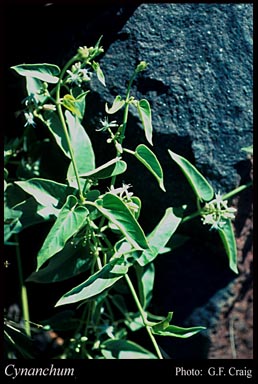- Reference
- Sp.Pl. 1:212 (1753)
- Name Status
- Current

Scientific Description
Common name. Djumbu. Family Asclepiadaceae.
Sometimes included in Apocynaceae. Subfamily Asclepiadoideae, Tribe Asclepiadeae.
Habit and leaf form. Shrubs, or lianas, or herbs, or herbaceous climbers; laticiferous (with clear, white or yellow latex). ‘Normal’ plants. Plants with roots (fibrous). Perennial. Leaves cauline. To 1 m high (when erect). Self supporting, or climbing. Helophytic, or mesophytic. Leaves small, or medium-sized; not fasciculate; opposite; not decurrent on the stems; with blades (or rarely reduced to scales); fleshy, or leathery, or ‘herbaceous’; not imbricate; petiolate (or with petiole grading into lamina). Petioles winged (on species with petiole grading into lamina), or wingless (usually). Leaves with ‘normal’ orientation; simple; epulvinate. Leaf blades dorsiventral; entire; flat; elliptic, or oblong; (1–)4–13 -nerved; pinnately veined (or obscurely so); cross-venulate, or without cross-venules (in C. pedunculatum and the erect species excluding C. christineae); cuneate at the base, or rounded at the base, or cordate, or attenuate at the base (or truncate, or lobulate). Leaf blade margins entire; flat.
Reproductive type, pollination. Fertile flowers hermaphrodite. Unisexual flowers absent. Plants hermaphrodite. Plants homostylous.
Inflorescence and flower features. Flowers aggregated in ‘inflorescences’; in umbels, or in racemes (‘fascicles’). Inflorescences simple; axillary. Flowers pedicellate; small; regular; 5 merous; cyclic; tetracyclic. Free hypanthium absent. Hypogynous disk absent. Perianth with distinct calyx and corolla; 10; 2 -whorled; isomerous. Calyx present; 5; 1 -whorled; gamosepalous; lobed. Corolla present; 5; 1 -whorled; appendiculate; gamopetalous; lobed; lobulate. Corolla lobes markedly longer than the tube. Corolla valvate, or imbricate; rotate, or campanulate, or urceolate; regular. Corolla members entire. Androecium present. Androecial members definite in number. Androecium 5. Androecial members adnate (epipetalous); united with the gynoecium (as a gynostegium); all equal; coherent (connate); 1 -whorled. Stamens 5; all more or less similar in shape (not markedly capitate); isomerous with the perianth. Filaments appendiculate (in a staminal gynostegial corona composed of 5 staminal lobes or highly fused staminal and interstaminal parts); connate into a tube, adnate to stigma. Anthers all alike; appendaged. The anther appendages apical. Pollen shed in aggregates; in tetrads. Gynoecium 2 carpelled. The pistil 2 celled. Carpels reduced in number relative to the perianth. Gynoecium syncarpous; synstylous; superior. Ovary plurilocular; 2 locular. Gynoecium stylate. Styles 2; partially joined (at the stylehead); apical. Stigmas 1; depressed-globose to umbonate or conical. Placentation axile. Ovules 30–50 per locule (‘many’).
Fruit and seed features. Fruit 3.5–95 mm long; dehiscent; 1 locular (in 2 follicles, with one often aborting). Dispersal unit the seed. Seeds endospermic; compressed (ovate to oblong); conspicuously hairy (comose at micropylar end), or not conspicuously hairy; with a tuft of hairs, or without a tuft of hairs. Cotyledons 2.
Geography, cytology, number of species. World distribution: occurring worldwide. Native of Australia, or adventive. Endemic to Australia, or not endemic to Australia. Australian states and territories: Western Australia, South Australia, Northern Territory, Queensland, New South Wales, and Australian Capital Territory. Northern Botanical Province and Eremaean Botanical Province. 11 species in Australia. As circumscribed in Forster (1996), Cynanchum is polyphyletic. Worldwide revisions of the various groups currently included in Cynanchum are necessary before the Australian taxa are relocated to other genera. A genus of 200 species; 4 species in Western Australia; 0 endemic to Western Australia.
Additional comments. From the Greek kynos (dog) and ancho (to strangle), alluding to the use of some European species to poison wild dogs and other vermin.
Additional characters Calyx with colleters (secreting mucilage) (at sinus bases). Annular corona absent. Corolline corona absent. Gynostegial corona present; consisting of lobes (or highly fused staminal and interstaminal parts); staminal, or interstaminal. Gynostegial staminal corona without a conspicuous hump; without an adaxial appendage. Corpusculum oblong. Caudicles not winged; not geniculate. Pollinia in the anther locule pendulous; pellucid germinating mouth of pollinia absent. Pollen tetrads linear. Mature leaf blades bearing colleters (at lamina base), or lacking colleters (in C. carnosum).
Etymology. From the Greek for "dog" and "to strangle"; refers to the poisonous properties, enough to kill a dog.
Taxonomic Literature
- Australian Biological Resources Study 1996. Flora of Australia. Volume 28, Gentianales. CSIRO.. Melbourne..
- Blackall, William E.; Grieve, Brian J. 1981. How to know Western Australian wildflowers : a key to the flora of the extratropical regions of Western Australia. Part IIIB, (Epacridaceae-Lamiaceae). University of W.A. Press.. [Perth]..